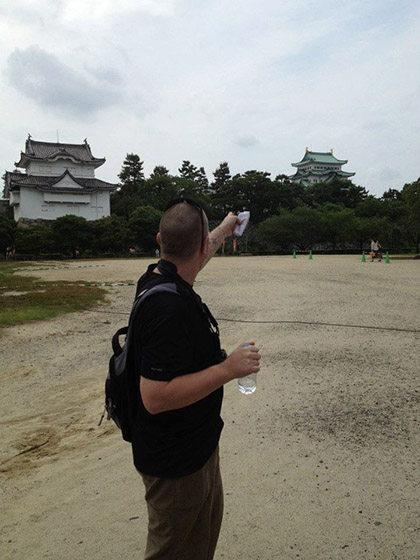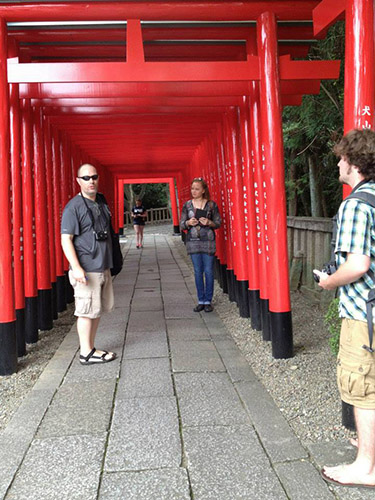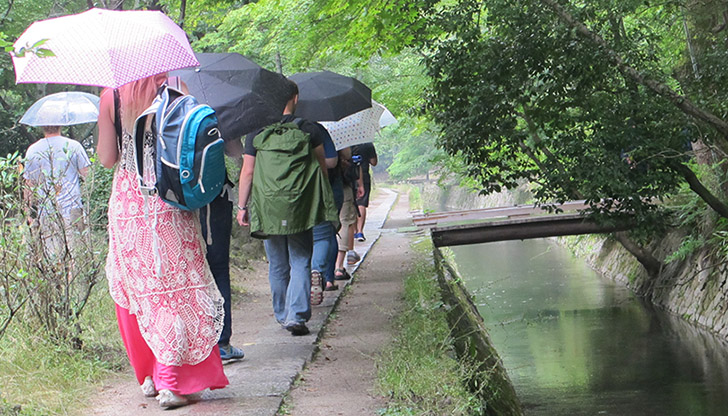Study Abroad, Pedagogy, and “Expedient Means”
Introduction: “Fingers Pointing at Castles”
In June of 2013, I helped lead a group of undergraduate students from West Virginia University on a three-week study abroad trip to Japan. As part of my job responsibilities within the Program for Religious Studies, it would be the first time I had been in charge of coordinating such an excursion, having had the opportunity to visit parts of Israel the previous summer on a colleague’s trip so as to “get the hang” of things and “learn the ropes” of short-term study abroad. I had been teaching part-time, and now full-time, for over fifteen years but never outside of the classroom. Then, with the help and support of my wife and disciplinary colleague, I found myself about to begin a three-week adventure in travel, advice, and daily student mentorship; and by association, an almost continuous, usually spontaneous, strategic experiment in on-site pedagogical techniques.

Author at Nagoya-jo. Nagoya, Japan, 2013
Photo Credit: Alyssa Beall
In preparation, my students and I spent the better part of a year working through various undergraduate courses on Japanese religious culture, history, and practice, including Religions of China and Japan, Asian Sacred Scriptures, Zen Buddhism, and Religion and Culture and Contemporary Japan. Specifically, we immersed ourselves in a literary and pragmatic worldview that many practicing and teaching Buddhists would recognize as “upayic,” if I can make an adjective out of the classic Sanskrit pedagogical term upaya, one of “expedient means.” Yes, we learned about Siddhartha, the historical Buddha, and about the various political sects of practice like Theravada, Mahayana, and Vajrayana. Yes, we studied and debated philosophic ideas and concepts like “interdependence” (pratitya-samutpada), “impermanence” (anicca), “emptiness” (sunyata), and “no-thingness” (anatman). And yes, we tried to put the Four Noble Truths into their historical context and to generate adequate interpretations of certain sacred texts (sutras). We even debated the merits and demerits of the “precepts” (sila). Finally, we desperately tried to imagine, with as much detail as possible, the various relationships between personal and social salvation that Japanese practices like meditation, tea ceremonies, flower arrangements, archery, calligraphy, and even koan practice, might embody. In sum, we compared and contrasted, with as much academic vigor as possible, the interrelationships between Japanese politics, colonial Buddhism, imperial Chinese influences like Taoism and Confucianism, and indigenous traditions like Shinto; and of course, we included the post-WWII conditions in Japan that led to the now-variegated and complicated forms of secularity, new religious movements, and 21st century expectations/anxieties of new generations today.
Nothing, however, could have prepared us for our first morning out on the city streets of Nagoya. No amount of coursework, no amount of reading, no amount of theoretical or philosophical sophistication, no fancy pedagogical dance within the comfy confines of the classroom prepared me for the first time I found myself, with twelve bright, eager, slightly naive, and greatly jet-lagged students, standing before the first supposed site of interest on our trip’s itinerary. And so, as the photo above attests, I found myself leading them up to the sprawling public grounds of Nagoya-jo (Nagoya Castle). And there, to my own shock and surprise, I began my first unplanned lecture by “pointing” at the looming structure (a metaphor for the next three weeks of teaching anxiety!) that we were ever-so-slowly approaching. I cannot help but think of the many classic examples of “fingers pointing at moons” in so much of the academic literature; hence I ask the pedagogical questions: Who/what spoke on this trip, and how, and for whom? Was it me, or was it the structures, history, and inherent Japanese meanings and material cultures themselves that I found myself precariously pointing at?
One Torii Forward, Two Toriis Back
These stories are part of a larger discussion about the benefits (one step/torii forward) and pitfalls (two steps/torii back) of extending the student learning experience into travel outside the university or college. We ask questions about how these travel experiences benefit students in the long term and how study abroad might make us better teachers. We explore the most useful paths to prepare for and implement different methods of teaching and learning while abroad, as well as how to incorporate those lessons into our classrooms back at home. Specifically, we pursue particular teaching and learning techniques that provide the best experience [read: most useful] for study abroad participants, and we explore whether culturally specific pedagogies like upaya can be incorporated into the more traditional, lecture-based experiences; if so, where or how?
In Sanskrit, upaya is defined as “expedient means” and is often combined with the term kaushalya (“cleverness”), forming upaya-kaushalya, meaning “skill in means.” Upaya-kaushalya emphasizes that teachers/practitioners may use specific methods or techniques that befit the situation—a skill which refers to the ability to adapt one’s message to any audience. The most important concept in “skill in means” is the use of a specific teaching (means) geared to the particular audience taught. Edward Conze, in A Short History of Buddhism, says “‘Skill in means’ is the ability to bring out the spiritual potentialities of different people by statements or actions which are adjusted to their needs and adapted to their capacity for comprehension.”

Author at Sanko-Inari Jinja. Inuyama, Japan, 2013.
Photo Credit: Alyssa Beall
Several days after Nagoya-jo and wondering just how spontaneous and effective my on-site teachings had gone, I found myself literally standing within a tunnel of torii gates (shrines demarcating the presence of the “sacred”) at Sanko-Inari Jinja in Inuyama, with one trusting student apparently ready and willing to move forward and through, and yet another hanging back, seemingly hesitating, if just for a moment, to follow me to the next big thing. What do I say? What do I do? What technique to I employ? What strategy do I apply? As a teacher, how do I teach on the fly, how do I mediate meaning and context while sweating and re-hydrating? How do I talk about the “sacred” in Japan while constantly taking one step forward, and two steps back?
Before coming to Japan, my students and I learned about Buddhist teaching techniques indebted to legends, history, and myths like the Buddha’s famous Flower Sermon, Master Joshu’s infamous “Mu!”, the sixth Patriarch Hui-neng’s “sudden” enlightenment, Basho’s haiku, and Chuang-tzu’s poetic and real-life wandering. Within all of them simmered a refusal to dogmatize, a refusal to canonize, a refusal to systematize or categorize. They all point to esoteric, spontaneous, and unpredictable styles of teaching and learning that harbor great potential, in my opinion, for application to study abroad situations and scenarios.
Nostalgia: Coming Home and Beginning Again

WVU 2013 Study Abroad Students. Yasukuni Jinja Shrine, Tokyo, Japan.
Photo Credit: Alex Snow
Our trip that first summer lasted three weeks, and by the end, we were all physically, emotionally, and intellectually drained. Above you see the students walking out of Yasukuni Jinja in Tokyo. The next morning they would all, somewhat nostalgically, catch a flight at Narita Airport for the long trip back home. They have been pushed to consider issues of spirituality, history, gender, language, and food incredibly foreign to them all. They have dealt with the prescience of politics, specifically that day at Yasukuni, struggling to understand the complexities of war, geopolitics, and religion. And so, trailing somewhat behind, I took a small snapshot of these weary travelers and wondered if they’d learned what they/I/we set out to learn three weeks previous while sitting at the departure gate in Pittsburgh International Airport.
However, the religions, philosophies, and worldviews of Japan necessitate openness to repetition. After another year’s refection, another year’s worth of teaching, research, and planning, another year’s worth of expectations and anxieties, I set out to do it again! Below is a photo of a new set of students that embarked on the “Philsopher’s Walk” (Tetsugaku-no-Michi) the following summer, in 2014.
.jpg)
WVU 2014 Study Abroad Students, Tetsugaku-no-Michi, Kyoto, Japan, 2014.
Photo Credit: Alex Snow
Resources
Adarkar, Aditya and David Lee Keiser. 2007. “The Buddha in the Classroom: Toward a Critical Spiritual Pedagogy.” Journal of Transformative Education 5 (3): 246–261.
Hick, John. 1991. “Religion as ‘Skilful Means’: A Hint from Buddhism.” International Journal for Philosophy of Religion 30 (3): 141–158.
Olson, Carl. 1983. “Beatings, Shouts and Finger Raising: A Study of Zen Language.” Journal of Religious Studies 10 (2) 45–50.
Samuels, Jeffrey. 2004. “Toward an Action-Oriented Pedagogy: Buddhist Texts and Monastic Education in Contemporary Sri Lanka.” Journal of the American Academy of Religion 72 (4): 955–971.
Sarbacker, Stuart Ray. 2005. “Skillful Means: What Can Buddhism Teach Us About Teaching Buddhism.” Method & Theory in the Study of Religion 17 (3): 264–273.
Smith, David Geoffrey. 1997. “Identity, Self, and Other in the Conduct of Pedagogical Action: An East/West Inquiry.” Counterpoints 67: 265–280.
Teece, Goeff. 2008. “Learning From Religions as ‘Skilful Means’: A Contribution to the Debate About Identity of Religious Education.” British Journal of Religious Education 30 (3): 187–198.
Tsai, Julius N. 2008. “Learning About Teaching From the Traditions We Teach: Reflections on an Undergraduate Buddhism Course,” Teaching Theology and Religion 11 (3): 159–164.
 Alex Snow is teaching assistant professor in the religious studies program at West Virginia University. For the past two decades he has been avidly studying, writing, and teaching mostly on Asian conceptions of “self,” “sound,” and “place.” His research and teaching embeds these ideas within the comparative context of Japanese Zen, Islamic Sufism, and the theoretical/cosmological sciences. His current courses at WVU include: Introduction to World Religions, Religions of India, Religions of China and Japan, Studies in Asian Scriptures, Religion and Science, Comparative World Theologies, Religion and Mysticism, Religion and Music, and Zen Buddhism. As a coincidental and professional extension of his own continued globe-trekking, he led study abroad programs to Japan during the summers of 2013 and 2014 and will be leading two more this upcoming summer of 2015: one to Vietnam and Cambodia, and the other to southern Spain.
Alex Snow is teaching assistant professor in the religious studies program at West Virginia University. For the past two decades he has been avidly studying, writing, and teaching mostly on Asian conceptions of “self,” “sound,” and “place.” His research and teaching embeds these ideas within the comparative context of Japanese Zen, Islamic Sufism, and the theoretical/cosmological sciences. His current courses at WVU include: Introduction to World Religions, Religions of India, Religions of China and Japan, Studies in Asian Scriptures, Religion and Science, Comparative World Theologies, Religion and Mysticism, Religion and Music, and Zen Buddhism. As a coincidental and professional extension of his own continued globe-trekking, he led study abroad programs to Japan during the summers of 2013 and 2014 and will be leading two more this upcoming summer of 2015: one to Vietnam and Cambodia, and the other to southern Spain.
Image: West Virginia University 2014 Study Abroad Students. Tetsugaku-no-Michi, Kyoto, Japan, 2014. Photo Credit: Alex Snow

